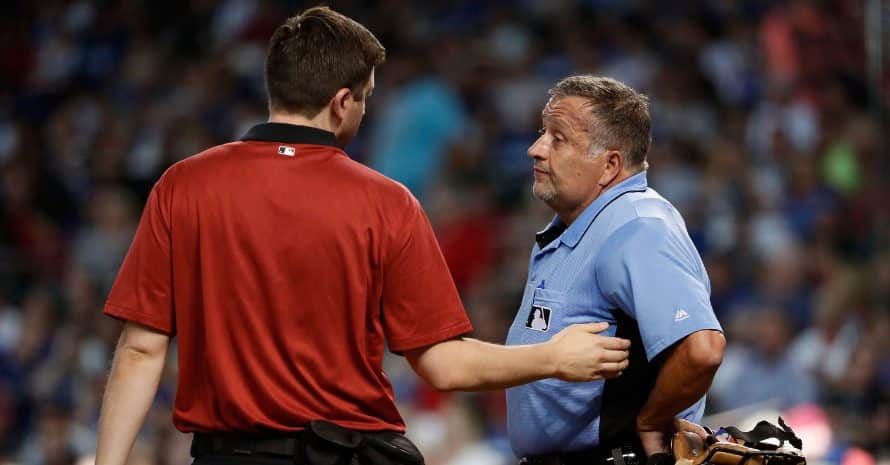FOUL TIP: Home plate umpire Dale Scott gets looked at by an Arizona Diamondbacks trainer after getting hit by a foul ball at Chase Field in 2016. Scott retired from MLB after the 2017 season. (Getty Images)
Former Major League Baseball umpire Dale Scott made the right call when he predicted players would go through an adjustment period to understand the big leagues’ new pitch clock rule.
Scott addressed the pitch clock, as well as automated ball-strike technology during his keynote address at the recent Stadium Managers Association seminar in Hollywood, California. The high-tech systems are all part of MLB’s strategy to speed up the pace of the game and draw new generations of fans to the sport.
The pitch clock, in effect for the 2023 season, affected the outcome of games and at-bats during the first weekend of MLB spring training as officials strive to speed up the pace and ultimately draw new fans to the sport. On Friday, the Boston-Atlanta spring game ended in a 6-6 tie after Braves minor leaguer Cal Conley, with the bases loaded, two outs and a full count, failed to get in the batter’s box in time and be ready for the pitch.
Under the new rule, pitchers have 15 seconds from the time they receive the ball to start their delivery when the bases are empty and 20 seconds between pitches with runners on base. Batters must be in the box and ready by the time the countdown clock reaches eight seconds. Violations by the pitcher result in an automatic ball; violations on the part of the batter result in an automatic strike.
“I’m happy for the pitch clock (in MLB), because we don’t get paid by the hour,” said Scott, who worked close to 3,900 big league games, including five no-hitters, and made 90 ejections over his 32-year career in the bigs. “I don’t think you’ll see much improvement (this year) in a big league setting, but in two to three years, there’s going to be an influx of all these players that are used to this system in the minors.”
On its own, Minor League Baseball has used the pitch clock over the past seven seasons.
Last season, the pitch clock shaved an average of 25 minutes off the length of minor league games to two hours, 38 minutes, according to the Associated Press. In the majors, without a pitch clock, nine inning games in 2022 ran an average of three hours and four minutes. Regulation-length games have not been shorter than two hours and 40 minutes since the 1995 season, Baseball Reference reported.

BALLS AND STRIKES: Former MLB umpire Dale Scott was the keynote speaker for the 2023 SMA seminar. (Don Muret/Staff)
“Baseball is a great game, but they want to build newer and younger fans and everybody has the attention span of a fruit fly,” Scott said. “MLB wants to try to get those games down to within a three-hour window and not draw it out. Hopefully, it will do what it’s supposed to do.”
Scott has seen greater use of technology integrated into MLB over the past decade, starting with instant replay, which was initially implemented to help determine whether batted balls landed in fair or foul territory.
“I was all for it, because stadiums now are fan friendly (with seats closer to the field of play),” he said. “To us, that means an umpire’s nightmare, because you have many more opportunities for spectator interference and it makes our life a living hell. Then, we went to expanded replay, and I was all for that. Even though we never want to miss a call, we would correct it and move on and that’s what people want, is to get it right.”
Now, as MLB enters year three of testing an automated ball-strike system in the minors and moves closer to installing the technology at the highest level of baseball, Scott said there’s more nuances involved, tied to the definition of a strike as the ball crosses the plate.
“I’ve always said, there’s an art and science to umpiring,” he said. “The science are the rules and that’s the nuts and bolts of the game. The art is applying those rules at the major league level. As we all know, a breaking ball at the very front edge of the plate, at the knees, going away from the hitter and toward the ground, is technically a strike and we don’t call it a strike. Why? Because no one expects it to be a strike. ABS doesn’t have the art, just the science, and it’s going to call that (pitch) a strike. Maybe we’ll )all get used to that, but what they may have to do is tweak the definition of a strike a little bit better to work with or against it.”
Instant replay has had some unintended circumstances, and Scott sees the same situation evolving with ABS. A runner that’s called safe at second base, for example, “nobody bats an eye,” Scott said, but if the infielder keeps his glove touching the runner, and if the runner strays off the base just a bit and the opponent challenges the call and it gets overturned, “that’s a cheap out and that’s not what replay is for.”
Under ABS, to provide another example of “what if,” Scott said there could potentially be a situation with a full count and runners on first and second that are running on the pitch. The umpire may call ball four on the hitter, but the opponent’s challenge overturns it to a strike. For the team in the field, it could be a disadvantage if the catcher did not attempt to throw a runner out under the original call, he said.
“I’m sure they’ll work it out,” Scott said. “You can’t outrun technology. I’m against (ABS), but let’s see how it plays out. It’s coming, so get ready for it.”







